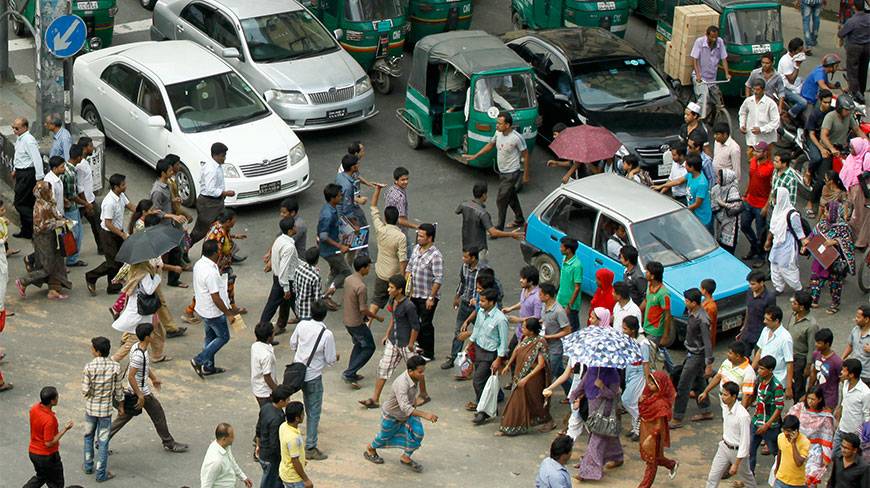They are not written anywhere, not even on the Bangladesh Road Transport Authority’s (BRTA) website
“Follow traffic rules” is the most meaningless campaign in Bangladesh ever. If you want to know why I think so, please read on.
First of all, yes, I will follow the traffic rules. But do I know what they are? Of course, you might be fined, punished, or be forced to offer a bribe if the traffic officer in charge thinks you have violated a traffic rule, because not knowing the law is not an excuse. Traffic rules are quite universal, meaning they are almost the same in any country, except in Bangladesh, for sure, and learning the Bangladeshi traffic rules is a big challenge.
They are not written anywhere, not even on the Bangladesh Road Transport Authority’s (BRTA) website. Yes, there is a page named “traffic signs,” and let me shed some lights on the state of the information presented on this page: Plenty of different traffic signs, though not all, are found on this page.
It also says, only in English, what each sign is, but doesn’t explain what the driver should do upon seeing these signs. For instance, a “roundabout” sign is translated as “there is a roundabout ahead,” but I also need to learn that it means that the car already in the roundabout has the right of way, and I should give way to that car when entering the roundabout. Unfortunately, drivers in Bangladesh have no way to learn about right of way, the understanding and following of which, to me, is actually a large part of following traffic rules.
Even more ironically, some of the signs on the BRTA’s webpage are also misinterpreted and hence, are misleading (See: http://www.brta.gov.bd/index.php/traffic-signs/36-road-markings). The double broken line is interpreted as “vehicles must give way to traffic on the major road or roundabout,” whereas it actually means that vehicles from both lanes or sides can switch lanes, or overtake if it is safe to do so.
Even a kid understands that following traffic rules is driving on the right side of the road. But you frequently see army vehicles, government vehicles, cars with press signs, and motorcycles plying on the wrong side of the road as if the wrong side is the right side for them.
Often, if you are driving an expensive SUV on Dhaka roads, the police helplessly watch you drive away on the wrong side as well. Who knows, you might be a relative of some bigshot who knows some big gun in the police department and can put your job at risk. Legally, the only vehicles which are maybe allowed to drive on the wrong side are ambulances and police cars, provided they are on emergency duty.
To me, following traffic rules means keeping your vehicle fit. How many public transports and police vehicles have you seen which are actually fit to be on the road with all the signal lights still attached and functioning? Government vehicles are in no better conditions either.
If following traffic rules means wearing seatbelts for drivers and front-seat passengers, show me one bus or minibus, or truck or human hauler in Bangladesh in which the driver has ever worn a seatbelt?
If you tell me that following traffic rules means following the speed limit while driving, then every road in Bangladesh must have speed limit indications. You can literally count the number of speed limit signs in the entire country, and I doubt the number will cross a hundred.
What is the speed limit on the Dhaka-Chittagong expressway? I am a frequent traveller on this road, and I don’t remember noticing a single speed limit sign along the 272km expressway.
I understand that following traffic rules means following the road marks when driving, but how many roads in the heart of Dhaka actually have road marks? For most roads in the capital, you can’t even find any indications of lanes on them, let alone the roads outside it.
Oh yes, following traffic rules surely means following traffic signals. Can someone tell me what I should do when the signal is green and the traffic police in the junction shows a stick to indicate that I should “stop,” or when the signal is red and the traffic officer waves a “go ahead signal?”
They get really vexed if you don’t notice them and try to act accordingly to the signals. Why can’t they just switch off the signal when they control the traffic manually?
Before we ask people to follow traffic rules, we should agree on what they actually are. The authority should then publish a driver’s handbook with all the rules spelled out both visually and in writing, and definitely in Bangla, if not in both languages, and make it available to drivers and learners.
All roads must have the proper signage and markings and the officials concerned must be trained to understand the interpretations of these signs. Only then will it make sense to ask people to follow traffic rules. Otherwise, it is a far cry.
Source: Dhaka Tribune










